
The Kingdom of Croatia entered a personal union with the Kingdom of Hungary in 1102, after a period of rule of kings from the Trpimirović and Svetoslavić dynasties and a succession crisis following the death of king Demetrius Zvonimir. With the coronation of King Coloman of Hungary as "King of Croatia and Dalmatia" in 1102 in Biograd, the realm passed to the Árpád dynasty until 1301, when the (male) line of the dynasty died out. Then, kings from the Capetian House of Anjou, who were also cognatic descendants of the Árpád kings, ruled the kingdoms. Later centuries were characterized by conflicts with the Mongols, who sacked Zagreb in 1242, competition with Venice for control over Dalmatian coastal cities, and internal warfare among Croatian nobility. Various individuals emerged during the period, such as Paul I Šubić of Bribir, who was representing the most powerful Croatian dynasty at the time, the Šubić noble family. These powerful individuals were on occasion able to de facto secure great deal of independence for their fiefdoms. The Ottoman incursion into Europe in the 16th century significantly reduced Croatian territories and left the country weak and divided. After the death of Louis II in 1526 during the Battle of Mohács and a brief period of dynastic dispute, both crowns passed to the Austrian House of Habsburg, and the realms became part of the Habsburg monarchy.
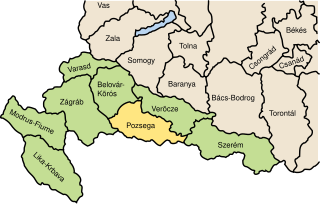
Požega County was a historic administrative subdivision (županija) of the Kingdom of Croatia-Slavonia. Croatia-Slavonia was an autonomous kingdom within the Lands of the Crown of Saint Stephen (Transleithania), the Hungarian part of the dual Austro-Hungarian Empire. Its territory is now in eastern Croatia. The capital of the county was Požega.
Tomislav was the first king of Croatia. He became Duke of Croatia c. 910 and was crowned king in 925, reigning until 928. During Tomislav's rule, Croatia forged an alliance with the Byzantine Empire against Bulgaria. Croatia's struggles with the First Bulgarian Empire eventually led to war, which culminated in the decisive Battle of the Bosnian Highlands in 926. In the north, Croatia often clashed with the Principality of Hungary; the state retained its borders and, to some extent, expanded with the disintegrated Lower Pannonia.

Petar Snačić was a feudal lord, notable for being one of the claimants of the Croatian throne between c. 1093 and 1097. It is assumed that he began as a ban serving under king Demetrius Zvonimir of Croatia and was then elected king by the Croatian feudal lords in 1093. Petar's seat of power was based in Knin. His rule was marked by a struggle for control of the country with Coloman of Hungary, dying at the Battle of Gvozd Mountain in 1097.

Peter Krešimir IV, called the Great was King of Dalmatia and Croatia from 1059 until his death in 1074 or 1075. He was the last great ruler of the Krešimirović branch of the Trpimirović dynasty.

The Trpimirović dynasty was a native Croatian dynasty that ruled in the Duchy and later the Kingdom of Croatia, with interruptions by the Domagojević dynasty from 845 until 1091. It was named after Trpimir I, the first member and founder. The most prominent rulers of the Trpimirović Dynasty include Tomislav, Petar Krešimir IV and Demetrius Zvonimir. The house gave four dukes, thirteen kings and a queen.
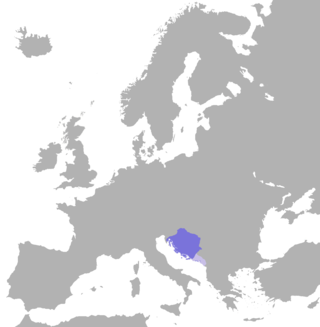
The Kingdom of Croatia, or Croatian Kingdom, was a medieval kingdom in Southern Europe comprising most of what is today Croatia, as well as most of the modern-day Bosnia and Herzegovina. The Croatian Kingdom was ruled for part of its existence by ethnic dynasties, and the Kingdom existed as a sovereign state for nearly two centuries. Its existence was characterized by various conflicts and periods of peace or alliance with the Bulgarians, Byzantines, Hungarians, and competition with Venice for control over the eastern Adriatic coast. The goal of promoting the Croatian language in the religious service was initially introduced by the 10th century bishop Gregory of Nin, which resulted in a conflict with the Pope, later to be put down by him. In the second half of the 11th century Croatia managed to secure most coastal cities of Dalmatia with the collapse of Byzantine control over them. During this time the kingdom reached its peak under the rule of kings Peter Krešimir IV (1058–1074) and Demetrius Zvonimir (1075–1089).
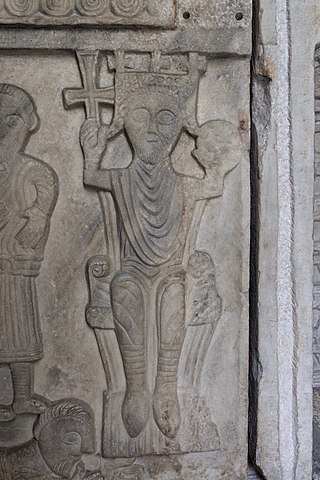
Demetrius Zvonimir was a King of Croatia and Dalmatia from 1075 or 1076 until his death in 1089. Zvonimir also served as Ban of Croatia (1064–1074), and was named Duke of Croatia in around 1075. His native name was Zvonimir, but adopted the forename Demetrius at his coronation.
Paul I Šubić of Bribir was Ban of Croatia between 1275 and 1312, and Lord of Bosnia from 1299 to 1312. As the oldest son of Stephen II of the Šubić noble family, he inherited the title of count of Bribir. He was appointed ban in 1273. He was relieved from duty in 1274, following his involvement in disputes between the Dalmatian coastal cities of Trogir and Split, and was returned to office in 1275.
Branimir was a ruler of Duchy of Croatia who reigned as duke from 879 to c. 892. His country received papal recognition as a state from Pope John VIII on 7 June 879. During his reign, Croatia retained its sovereignty from both Carolingian and Byzantine rule and became de jure independent. His rule marks the first real peak of early medieval Croatia. It was characterized by establishing closer relations with the Holy See, ecclestical re-organization in the former Roman province of Dalmatia, Christianization, and (re)construction of churches. Branimir is mentioned, for the period, in many reliable primary and secondary written and ephigraphic sources.

Stephen I was King of Croatia from c. 1030 until his death in 1058 and a member of the Trpimirović dynasty. Stephen I was the first Croatian king whose given name was "Stephen" ("Stjepan"), as Držislav added the name Stephen at his coronation. His ban was Stephen Praska.
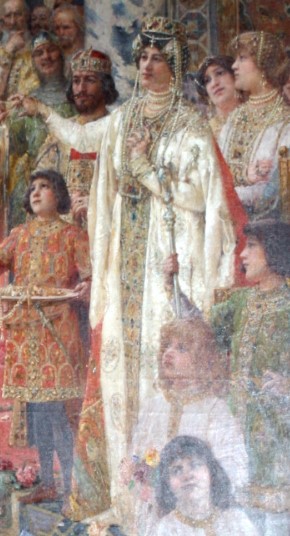
Helen of Hungary, also known as Helen the Fair, was a queen consort of Croatia.
Stephen II was the last member of the Trpimirović dynasty and last native king of Croatia to rule the entire medieval Croatian Kingdom. Stephen's father was Gojslav II, the younger brother of Peter Krešimir IV of Croatia. Stephen was duke of Croatia under Krešimir around 1066.

Ban of Croatia was the title of local rulers or office holders and after 1102, viceroys of Croatia. From the earliest periods of the Croatian state, some provinces were ruled by bans as a ruler's representative (viceroy) and supreme military commander. In the 18th century, Croatian bans eventually became the chief government officials in Croatia.

The Church of the Holy Salvation or Holy Saviour was a Pre-Romanesque church in the Dalmatian Hinterland, Croatia, whose ruins are now a historic site. It is located in the small village of Cetina, near the spring of the river Cetina, 8 km northwest from the town of Vrlika.

Hollow Church is the archaeological excavation of what used to be a Romanesque Roman Catholic church in the 11th-century Salona, Croatia.

Croatian Pre-Romanesque art and architecture or Old Croatian Art is Pre-Romanesque art and architecture of Croats from their arrival at Balkans till the end of the 11th century when begins the dominance of Romanesque style in art; that was the time of Croatian rulers.
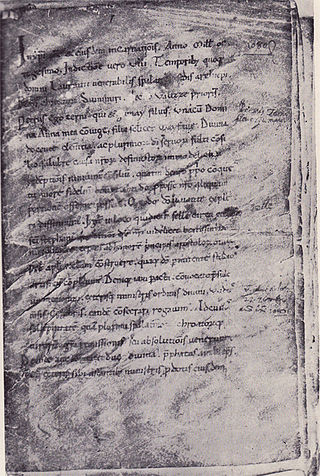
Supetar cartulary or Sumpetar cartulary is a 12th-century cartulary which contains charters from the years 1080 to 1187.
The twelve noble tribes of Croatia, also known as twelve noble families of Croatia, was a medieval institution of nobility, alliance, or narrow noble community in the Kingdom of Croatia, which can be traced back at least to the 14th century, while the first mention of the institution was in the Pacta conventa document, which is supposedly a later copy of the original from 1102. Regardless of possible earlier references, the first verifiable mention dates from 1350, while the last from 1459. It is considered that by socio-economic power it was composed of lower and middle nobility, which had a privilege of retain and use of heirdom, tax exemption, and limited military obligations to the king. The twelve tribes are Čudomirić, Gusić, Kačić, Kukar, Jamomet, Lasničić, Lapčan and Karinjan, Mogorović, Poletčić, Snačić, Šubić, and Tugomirić.













